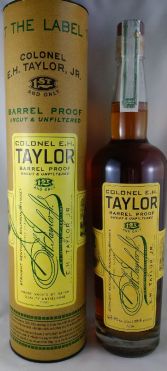Bourbon Whiskey Terms & Definitions
Bourbon Whiskey
In 1964 Bourbon was officially proclaimed as a spirit exclusive to the
United States of America.
Bourbon can be made anywhere in the U.S. and, by law, it is a product distinctive to the U.S. that must be made from a fermented “mash” of no less than 51% corn.
Other rules include being distilled at no more than 160 Proof (80% abv) and aged at no more than 125 proof (62.5% abv) for at least 2 years in new charred oak barrels.
It must be bottled at no less than 80 proof (40% alcohol by volume / abv)
 Barrel Proof:
Barrel Proof:
Barrel Proof refers to Whiskey that is bottled at the proof it comes out of the barrel after minimum aging of four years.
For example, a recent bottle of Colonel E.H. Taylor Barrel Proof was bottled at 127.5 proof.
To figure out the alcohol level, or abv (alcohol by volume) divide the proof by half, which equals 63.75 abv.
If the whiskey has a secondary package, like the canister for Colonel E.H. Taylor, the canister will state “Proof Varies by Batch”.
The label on the bottle inside will usually indicate the proof and / or alcohol by volume content.
Bonded Bourbon Whiskey:
There is a requirement for some whiskies to fall into what’s known as the:
“Bond Act of 1897”
“Bonded Bourbon Whiskey” has been aged and bottled according to the requirements of that act. The definitions include it being a:
Straight Bourbon Whiskey which is defined as:
> Distilled from a fermented mash containing at least 51% corn.
> Distilled at no more than 160 proof.
> Aged at no more than 125 proof for at least two years in new charred oak barrels. If the whiskey is aged for less than four years, its age must be stated on the bottle.
> No coloring – like caramel coloring – or flavoring, can be added.
Bonded Bourbon Whiskey must also be made at one time or season, in one location.
All Bonded Bourbon is aged in government-supervised warehouses for at least 4 years prior to being bottled at 100 proof aka 50%abv.
Mash Bill:
A “Mash Bill” is a recipe the distiller uses to make the whiskey. Keep in mind that for Bourbon, the Mash Bill must contain at least 50% corn … but most are made with up to 70% corn grain.
Small Batch:
When you see the term “Small Batch”, it refers to a style of Bourbon that is distilled in small quantities. Typically that’s about 20 barrels … or 1,000 gallons.
But it could also involve blending whiskey from a small number of selected barrels.
It’s important to note that whiskey will age differently depending on where the barrel is stored in the rackhouse. Generally, the sweet-spot is considered to be the center of the storage facility.
But a skilled master blender can pull barrels from various sections of the rackhouse, marrying the whiskies from various barrels, to achieve the consistent flavour for the house-profile.
Sour Mash:
Almost all American Whiskey is “Sour Mash” … meaning a portion – typically 20% of the mash – is held back before distilling.
This set-aside portion is then added to the next batch of distilling, and so on.
This assures consistency of the “yeast strain” which is critical to the Bourbons character.
The Sour Mash process was developed in the mid 1800’s by Dr. James C. Crow as a method to ensure uniform production for Bourbon.
Angel’s Share:
Whiskey is aged in oak which is porous, allowing for both an exchange of oxygen & the release of alcohol into the air.
Angel’s Share is the amount of whiskey that evaporates to the heavens from the barrel during the aging process.
Cooler climates, like Scotland or Canada will see an evaporation rate anywhere from 1% to 3% per year. In warmer climates, that rate can go higher.
Hot climates, like India, will often see evaporation rates of over 10%.
The other thing that affects evaporation is humidity. More water than alcohol will evaporate in low humidity – therefore increasing the a barrel’s alcohol content.
On the flip side, in humid conditions, more alcohol than water will become the Angel’s Share.
That’s why, when you’re looking to purchase an older bottle of whisky, the price will increase due to the lost yield as a result of the Angel’s Share.

